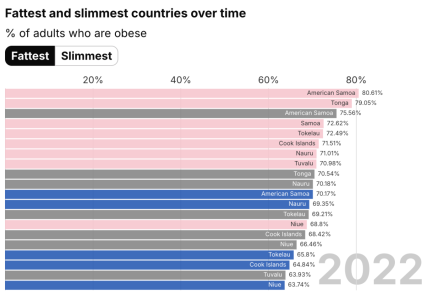Discover the Shocking Truth: The Fattest Countries on Earth Ranked – Where Do Britain and the US Stand? Exclusive Obesity Crisis Insight!
By
Seia Ibanez
- Replies 4
The global obesity crisis is a growing concern that has seen dramatic increases in prevalence over the past few decades. A recent analysis by MailOnline has revealed some startling statistics about the state of obesity around the world, and the findings are a wake-up call for many nations, including Britain and the United States.
In an age where convenience often trumps health, the world has witnessed a staggering 17-fold increase in obesity rates in certain regions over the past two decades. Out of 200 countries that have been historically monitoring their obesity rates, France stands out as the only nation to have seen a decrease in the share of obese adults between 1990 and 2022. On the other end of the spectrum, countries like Bangladesh, Nepal, and Burkina Faso have experienced jumps in obesity rates exceeding 1,000 percent.

The World Health Organization's data paints a grim picture, with global obesity rates having doubled, including in Britain and the US. Now, more than a billion people worldwide are classified as obese, with a Body Mass Index (BMI) above 30. The South Pacific has emerged as a hotspot for obesity, with American Samoa leading the pack where three-quarters of adults are considered obese.
When we delve into the specifics, the WHO figures reveal that French and Spanish women are less obese today than they were in 1990. However, male waistlines have expanded in every country. Back in 1990, countries like Vietnam, Timor-Leste, Ethiopia, and Bangladesh had the lowest obesity levels, with fewer than 0.3 percent of their populations considered obese.
The United Kingdom, which was 73rd on the world obesity list in 1990, has seen a significant increase in obesity rates, with 28.7 percent of the population now obese, up from 12.4 percent. The US has also seen a similar increase, with 42.9 percent of adults now obese, pushing the country up to 18th on the international obesity list.
Experts like Professor Alexander Miras from Imperial College London and Tam Fry, chairman of the National Obesity Forum, have expressed deep concern over these trends. They highlight the rapid rise in obesity levels, especially in parts of the world where poverty and food insecurity also prevail. Obesity is not just a standalone issue; it is a gateway to a host of other health problems, including type 2 diabetes, heart conditions, and kidney diseases, which can significantly increase healthcare costs.
In a surprising twist, recent statistics from the US Centers for Disease Control and Prevention (CDC) suggest that the obesity crisis might be showing signs of reversal, with a slight decrease in obesity rates from 42 percent to 40 percent between 2021-2023. This marks the first year-on-year decrease since the CDC began tracking this metric. The decline has been tentatively linked to the rise of new weight-loss drugs like Ozempic, which have shown powerful effects in combating obesity.
However, experts caution that it is too early to attribute this decline to obesity medications alone, and more data is needed to confirm any long-term trends. The COVID-19 pandemic has also had a complex relationship with obesity, causing weight gain for many but also increasing awareness of the risks associated with obesity.
In Britain, there is ongoing discussion about the potential use of GLP-1 receptor agonists, such as Wegovy and Ozempic, to help unemployed obese individuals return to work. While these drugs have shown promise, there are concerns about their misuse and the serious side effects they can cause.
The obesity epidemic is not just a health issue; it has significant economic implications, with obesity-related conditions costing the NHS around £6.5 billion annually. It is clear that tackling obesity requires a multifaceted approach, including public health initiatives, education, and potentially, medical interventions.
As we continue to grapple with the obesity crisis, it is essential to remember that prevention is key. Healthy eating, regular physical activity, and informed lifestyle choices remain the cornerstone of combating obesity. It is a battle that requires the collective effort of individuals, healthcare professionals, and policymakers.

We at the Seniors Discount Club encourage our members to stay informed and proactive about their health. Share your thoughts and experiences with us in the comments below. Have you noticed changes in your community's approach to obesity? What measures do you think are most effective in promoting a healthier society? Let's discuss and support each other in leading healthier lives.
In an age where convenience often trumps health, the world has witnessed a staggering 17-fold increase in obesity rates in certain regions over the past two decades. Out of 200 countries that have been historically monitoring their obesity rates, France stands out as the only nation to have seen a decrease in the share of obese adults between 1990 and 2022. On the other end of the spectrum, countries like Bangladesh, Nepal, and Burkina Faso have experienced jumps in obesity rates exceeding 1,000 percent.

Data has revealed the world's fattest and slimmest countries overtime. Credit: World Health Organisation
The World Health Organization's data paints a grim picture, with global obesity rates having doubled, including in Britain and the US. Now, more than a billion people worldwide are classified as obese, with a Body Mass Index (BMI) above 30. The South Pacific has emerged as a hotspot for obesity, with American Samoa leading the pack where three-quarters of adults are considered obese.
When we delve into the specifics, the WHO figures reveal that French and Spanish women are less obese today than they were in 1990. However, male waistlines have expanded in every country. Back in 1990, countries like Vietnam, Timor-Leste, Ethiopia, and Bangladesh had the lowest obesity levels, with fewer than 0.3 percent of their populations considered obese.
The United Kingdom, which was 73rd on the world obesity list in 1990, has seen a significant increase in obesity rates, with 28.7 percent of the population now obese, up from 12.4 percent. The US has also seen a similar increase, with 42.9 percent of adults now obese, pushing the country up to 18th on the international obesity list.
Experts like Professor Alexander Miras from Imperial College London and Tam Fry, chairman of the National Obesity Forum, have expressed deep concern over these trends. They highlight the rapid rise in obesity levels, especially in parts of the world where poverty and food insecurity also prevail. Obesity is not just a standalone issue; it is a gateway to a host of other health problems, including type 2 diabetes, heart conditions, and kidney diseases, which can significantly increase healthcare costs.
In a surprising twist, recent statistics from the US Centers for Disease Control and Prevention (CDC) suggest that the obesity crisis might be showing signs of reversal, with a slight decrease in obesity rates from 42 percent to 40 percent between 2021-2023. This marks the first year-on-year decrease since the CDC began tracking this metric. The decline has been tentatively linked to the rise of new weight-loss drugs like Ozempic, which have shown powerful effects in combating obesity.
However, experts caution that it is too early to attribute this decline to obesity medications alone, and more data is needed to confirm any long-term trends. The COVID-19 pandemic has also had a complex relationship with obesity, causing weight gain for many but also increasing awareness of the risks associated with obesity.
In Britain, there is ongoing discussion about the potential use of GLP-1 receptor agonists, such as Wegovy and Ozempic, to help unemployed obese individuals return to work. While these drugs have shown promise, there are concerns about their misuse and the serious side effects they can cause.
The obesity epidemic is not just a health issue; it has significant economic implications, with obesity-related conditions costing the NHS around £6.5 billion annually. It is clear that tackling obesity requires a multifaceted approach, including public health initiatives, education, and potentially, medical interventions.
As we continue to grapple with the obesity crisis, it is essential to remember that prevention is key. Healthy eating, regular physical activity, and informed lifestyle choices remain the cornerstone of combating obesity. It is a battle that requires the collective effort of individuals, healthcare professionals, and policymakers.
Key Takeaways
- Obesity levels have surged globally, with some countries experiencing increases of more than 1,000 per cent in adult obesity rates over the past two decades.
- France is the only nation that saw a decrease in the share of obese adults, while in the US and Britain, obesity rates have doubled, according to World Health Organization figures.
- American Samoa is ranked as the world's fattest nation, with three-quarters of its adult population being obese, followed closely by South Pacific neighbours Tonga and Naura.
- Health experts express concern over the rapid rise of obesity, particularly in countries facing poverty and food insecurity, noting the direct correlation between the availability of fast food, decreased physical activity, and the obesity epidemic.







